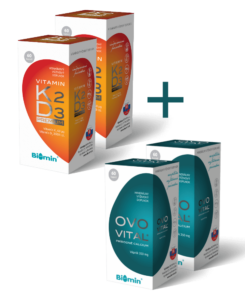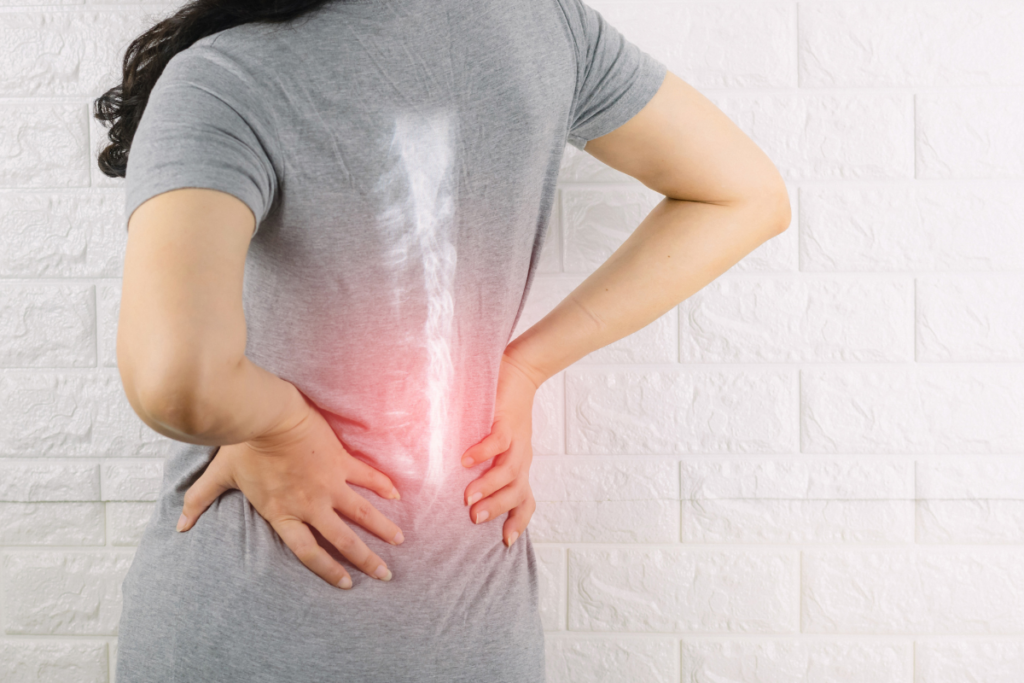Osteopenia is a “precursor” to the development of osteoporosis, a so-called warning signal that precedes osteoporosis. People with osteopenia have a higher risk of developing osteoporosis if they take no steps to improve their bone health. Osteopenia is often asymptomatic, so it is usually detected by chance during examinations for other reasons. At this stage, bones are weaker and the risk of fractures increases slightly. Osteoporosis is a chronic bone disease in which bone density gradually decreases, making bones thinner, more brittle and more prone to fracture.
The main difference between osteopenia andosteoporosis lies in the risk of fractures. Osteoporosis represents a significant loss of bone mass with a high risk of fractures.
Warning signs that may indicate osteopenia:
- Higher susceptibility to fractures: Fractures occur more easily than would be expected, most commonly of the wrist, forearm or hip.
- Bone and joint pain.
- Poor posture: Hunching or kyphosis can signal a weakening of the bones of the spine.
- Back pain: May be caused by a fracture or collapse of a vertebra.
- Height reduction: if you notice that you have shrunk by more than a few centimetres, this may be the result of compression fractures of the spine.
What causes osteopenia?
There are many factors that can lead to the development of osteopenia. Some of these you cannot control, but others can be worked with:
- Age: Bones naturally thin with age.
- HormonesA decrease in postmenopausal estrogen levels in women and low testosterone levels in men.
- GeneticsA: If you have a family history of osteopenia or osteoporosis, you are more likely to develop it.
- Calcium and vitamin D deficiency: These nutrients are crucial for healthy bones.
- Lack of exerciseA: A sedentary lifestyle weakens bones.
- Smoking and alcoholA: These bad habits damage the bones. Smoking reduces the body’s ability to absorb calcium and alcohol disrupts hormonal balance.
- Some medicinesA: Long-term use of some medicines, such as corticosteroids, can lead to thinning of the bones.
- Chronic diseasesA: Some diseases such as rheumatoid arthritis, celiac disease or Crohn’s disease can affect bone health.
- Eating disordersAnorexia and bulimia can cause low intake of nutrients essential for bone health.
Other factorsAge over 50, menopause before age 45, removal of ovaries before menopause, excessive caffeine drinking and use of prednisone or phenytoin
How to find out if you have osteopenia?
The most accurate method is densitometry, an examination that measures bone mineral density (BMD). The test is also called DXA (dual energy X-ray absorptiometry) and is painless. Your doctor may recommend it if he or she sees risk factors for osteopenia or osteoporosis. In practice, bone mineral density is usually measured in the lumbar spine, upper end of the femur and in the forearm area.
Densitometry results are expressed by T-scores and Z-scores. The T-score expresses the deviation from the bone density value in young healthy individuals, while the Z-score expresses the deviation from the ideal value in healthy individuals of the same age and sex.
The higher the mineral content of the bones, the denser, stronger and less prone to breakage they are.
What can you do for your bones?
Although osteopenia can’t always be cured completely, you can do a lot to slow its progression and reduce the risk of fractures. The important thing to focus on is:
A diet rich in calcium and vitamin D: Eat dairy products, green vegetables, fish and take calcium and vitamin D supplements (after consulting your doctor). The recommended daily intake of calcium is about 1000 mg for adults and 1200 mg for the elderly and postmenopausal women. The daily dose of vitamin D should be 1000-2000 IU.
Regular exercise: Exercise such as walking, running, dancing or strength training strengthens the bones.
Healthy lifestyle: Stop smoking and limit alcohol consumption.
Sunlight: Expose yourself to the sun so your body can make vitamin D (remember to protect yourself from excessive sunlight).
Regular medical check-ups: Get regular check-ups and consult your doctor on how best to protect your bones. Regular bone density testing (DEXA) is recommended after age 65.
Always consult your doctor for appropriate treatment and prevention of osteopenia. In some cases, your doctor may also recommend bone-strengthening medications. If osteopenia is not addressed, there is a risk that it will develop into osteoporosis. It is therefore important to undergo early diagnosis and take effective preventive measures.

The most important vitamins and minerals for strengthening your bones
Calcium – It is an essential component of bones and is essential for maintaining their strength and density. It is crucial for bone formation and development and influences bone structure and strength. It is recommended to take 1,000 milligrams of calcium per day for women under 50 and men under 70, and 1,200 milligrams of calcium per day for the elderly. Best Absorbable Calcium is natural calcium from egg shells without additives and preservatives.
Vitamin D – It is crucial for calcium absorption in the intestines. Vitamin D deficiency can lead to softening of the bones. The recommended daily dose of vitamin D is 1000-2000 IU.
Magnesium – It is important for proper bone mineralisation and helps in the metabolism of calcium and vitamin D. Magnesium aids in the absorption of vitamin D and promotes bone health by increasing the activity of bone-forming cells.
Vitamin K2 – It helps to get calcium to where it is needed, i.e. to the bones and teeth. It is important for the production of proteins needed for bone health, which bind calcium in bone tissue. Vitamin K2 also prevents calcium deposition in the blood vessels, heart or brain, eliminating the risk of heart and stroke.
Phosphorus – Together with calcium, it is the main component of the mineral structure of bones, which gives bones their hardness.
Vitamin C – It is essential for the formation of collagen in the bones, which ensures bone elasticity, its resistance and also promotes bone healing after fractures.









